28. Production
Focus: This chapter sets how the production system in WiTE2 operates and the rules for factory damage, repair and relocation.
Key Points:
- Elements of the production system
- How elements are constructed and manpower and equipment combined
- How different types of factories operate
- Factory damage, capture, relocation and repair
28.1 Outline
The production system in Gary Grigsby’s War in the East 2 simulates the generation of war material, manpower, fuel and supplies that flows into each side’s supply grid as replacements and supply for the war fronts. All production is based on various factories located in town, city and urban hexes. Resource, heavy industry, oil and fuel factories produce the basic materials used to run the production system and supply the forces.
There are two types of equipment production in the game: historical production for aircraft and AFV/Combat and generic vehicles based on a fixed amount each turn and demand based production for non-vehicle ground elements based on the difference between the nonvehicle TOE strength of a unit and its actual strength.
However, the latter may also face a cap on total production (28.1.4) so that production does not meet the full demand. Every aircraft, AFV and named combat vehicle has a build limit which caps the maximum number of frames or chassis that can be converted into elements each turn.
The manpower required is generated through manpower factories that represent the availability of able-bodied men for the armed forces. Factories can be damaged and repaired.
Though not directly part of the production system, ports and railyards are treated as factories that generate a certain amount of transportation capacity (25.4.1 and 25.6.1).
Once produced, supplies, fuel, oil and resources are transported through the supply grid to town, city and urban hexes where they are stored and can be drawn upon as necessary by the factories located in those particular hexes.
Other produced items are held in virtual pools until they are drawn upon to build Air Groups (aircraft), ground elements, and trucks. Each pool has an active (available) and in transit (currently unavailable) component (36.3.1).
Ships (both transport and cargo) as such are not produced but are generated as reinforcements but appear in geographical pools for each sea area (24.4).
The two displays below (figure 28.2), show current German production on T7 of the 1941 Campaign. At the top, the pools show all the possible components, the second image only shows the portion that is ‘active’ – in other words that could feasibly be used in production this turn.
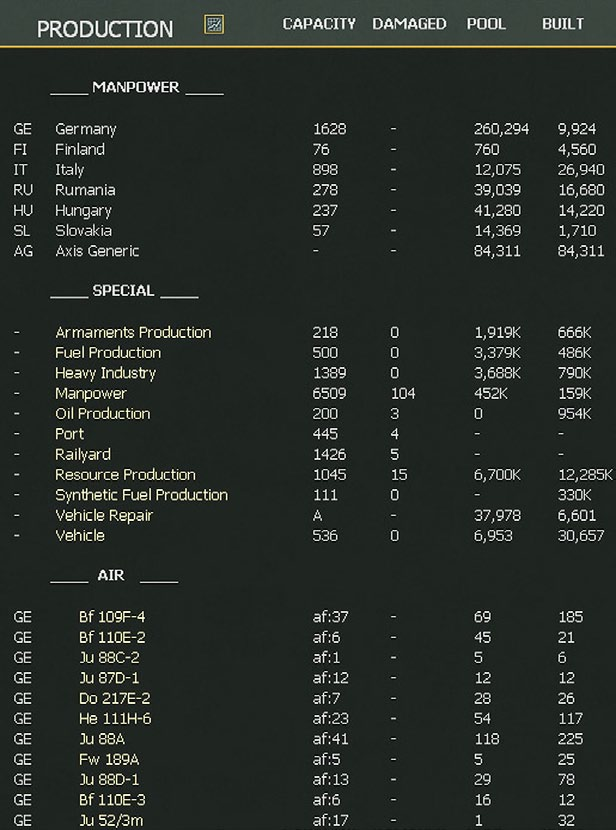

Each nation in the game has a set of pools used for building aircraft and ground elements. Polish and Czech factories are considered an integral part of the German pools and their production (and a portion of their manpower) is placed directly in the German pools.

Note that if you click on the nation (such as Germany) the main display will alter to only show the production from that particular country (or area). You can return the display to show all production by then clicking on ‘All Areas’.
Polish and Czech manpower factories can produce manpower for the Soviets if occupied by the Soviets. Soviet resources are used to build equipment and ground elements used by Polish, Czech and Romanian forces that are operating under Soviet command.
Production takes place for each side during their respective logistics phase.
There is no production of any kind during the first player-turn of turn one of any scenario (when the German is the first player then there will be Soviet production on turn one). Note that in scenarios where the Soviets are the first player, there is no Axis turn one.
Production in non-campaign scenarios that do not use the entire map and OOB is reduced for both sides by a certain percentage to account for production going to the off-map forces not involved in the scenario.
28.1.1 Summary of Information Provided
The logistics log (36.9) contains several reports that track the moves of various resources from production to usage.
The first shows movement of resources between cities as the various items needed for industrial production are moved around:
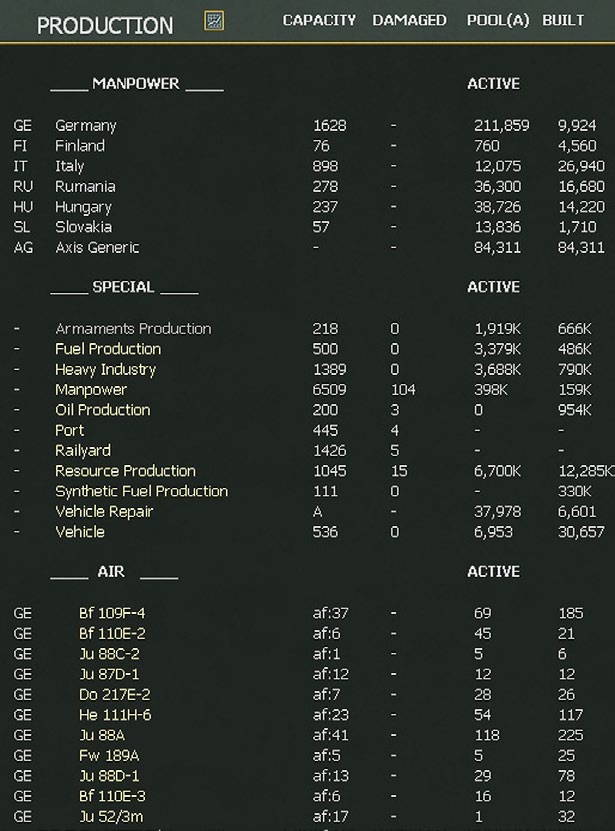
The second shows if any factories lack all the resources needed to operate at full effectiveness. In this case, shortfalls can either be related to a location being isolated from the main rail network or that a required input is in short supply across the system.

This information is then summarised into a table that shows the proportion of each factory type in use, how much it produces, how much resource it consumes in production and how many factories are operating at restricted production, no production or are isolated:
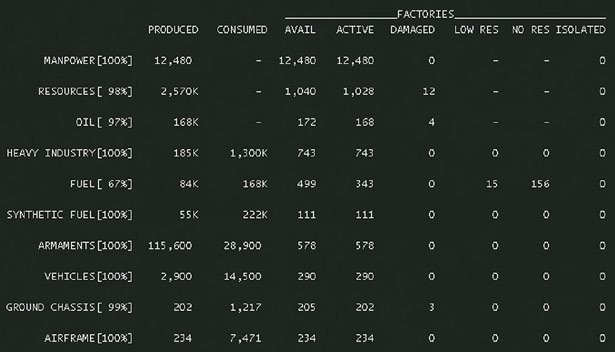
In turn, the Production screen (36.3) shows additional information. The basic table will show both total capacity (unmodified), how many production sites are damaged, how much is in the pool (by default this will be the total but can be filtered just to show the active amounts) and how much has been built all game. In the example below, 2 Soviet manpower factory points are damaged as they have only recently been recaptured.

Clicking on one of the entries will bring up a more detailed screen listing all the production sites for that item.
Delay indicates that the factory is not yet in full production. In turn clicking on the city name will take you to that location on the map.

The list of equipment pools in the production screen (36.3) is annotated to reflect their current status as follows:
- No longer in production (‘#’)
- Currently in production (no symbol)
- Not in production yet (**)

The only factories that will be considered physically present in town, city and urban hexes are those currently in production.
Selecting an aircraft or ground element equipment listed in the production screen will bring up information on the element characteristics, where it is produced and the upgrade paths.

28.1.2 Equipment Downgrades and Swaps
A ground element or Air Group can downgrade to a specific type of equipment if the production system determines that there is a shortage of current equipment that is unable to keep up with the demands of all of the units using that equipment and there is an excess of older equipment in the pool. In this case a unit may downgrade its aircraft or equipment to the item that is back along the upgrade path. For example, a German fighter Air Group that had upgraded from the Bf 109F-2 to the Bf 109F-4, but then took heavy losses, might downgrade back to the Bf 109F-2 if the Bf 109F-4 pool was low and there were excess Bf 109F-2’s available.
Under similar circumstances, Anti-Tank ground elements equipped with 75mm AT gun devices might downgrade back to the 47mm AT gun device.
In the swap sub-segment, the computer may also change out existing ground elements with ground elements of the same type (21.2). Depending on the unit TOE (21.2.7) it may look to use a different type of equipment than its preferred option. So a late war Soviet tank unit may use either the T34/44 as its medium tank or a lend-lease Sherman tank. These changes are listed in the logistics report, see figure 28-10.

28.1.3 Scrapping of Obsolete Equipment
Equipment that is no longer produced will begin to be removed from the production pool by scrapping after the last year of availability. Scrapping of obsolete equipment does not happen unless the equipment is no longer in a unit and no longer in the current TOE of a unit.
If these conditions are met, then an item can be scrapped. AFVs will not be scrapped if they are being used by any units in the game.
28.1.4 Production Constraints
Some production is made using generic resources (such as armament points). An important aspect of this is there is a cap on how many such elements can be produced in a given turn even if the resources exist to produce more.
These limits will vary across the game (as will the types of artillery and other guns) produced. The production in the previous turn can be found in the Logistics Log (36.9), as:

This will particularly affect the Soviet player in 1941 and 1942 when artillery production will be less than required to refit all the potential combat and support units. This means the Soviet player will need to be careful about how many units are placed to ‘refit’ in the National Reserve and whether it is worthwhile building extra units (even if they cost no administrative points to produce – 27.2.4). Related to this, historically production of Soviet heavy artillery was very low from late 1941 until 1944.
In effect these generic elements are only produced when needed but may not be produced in sufficient quantities to meet all the demand.
28.1.5 Equipment Exports
The export function in WiTE2 includes both the sending of equipment from Germany to its Axis Allies and the conversion of equipment within the armed forces of each side so that factories don’t have to be setup for every variant piece of equipment.
For example, a factory may only produce Me 262A fighters, but a certain number will be automatically converted into the Me 262A-1a/U3 and then placed in the appropriate pool.
When exporting ground elements or aircraft, no more than one quarter of what is currently in the pool will ever be exported on a turn.
Exports in the previous logistics phase can be seen in the logistics log.
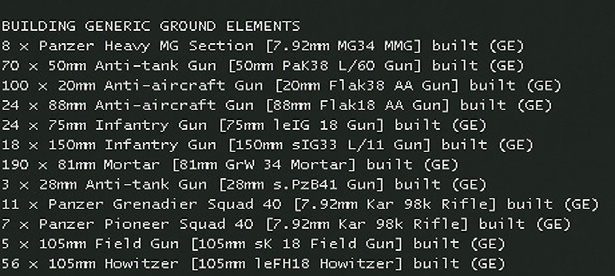
28.1.6 Impact of Damage on Production
The interaction between damage levels and production depends on the actual size of the damaged factory. A factory of size 2 with 90% damage will have 1 point damaged and the other functioning. A factory with size 11 with 25% damage will have 2 points actually damaged.
In effect, the damage % is applied to the total number of production units in a factory and rounded down.
28.2 The Generic Production System
Production is conducted by various factories located in town, city and urban hexes. Some factories are located off-map. Each factory point (level) will produce a certain amount of an item each turn if the town, city or urban hex it is located in is connected to the supply grid (25.2) and sufficient basic items are stored at the factory location for local use. There are three basic items required to allow the production system to run; resources, oil and manpower.
Resources are required by Heavy Industry factories to produce supplies and by synthetic fuel factories to produce synthetic fuel. Supplies are required by armament points and these are used, in turn, by, aircraft, AFV and combat vehicle factories to build the equipment for Air Groups and ground elements.
Oil, resources, supplies and fuel are normally moved over rail as freight. Much of city to city or city to pool deliveries of oil and fuel are conducted by pipelines independent of the rail network, so that half of all oil and fuel delivered in these cases do not use any rail capacity tonnage, however there has to be a rail network link in order for the pipelines to be considered to be functioning. Vehicles may be used to transport a small percentage of city needs that are not able to be moved by rail or sea.
Oil is required by fuel factories to produce fuel to allow motorized units to move and generic vehicles to operate.
Manpower factories provide the men that are matched with equipment during the replacement phase to build complete ground elements that flow to the units.
There are two types of production rates used for factories. Some factories (Heavy Industry, Fuel, Synthetic Fuel, Vehicle and Armaments) have a multiplier for each year (1941-45) that is used to determine the amount of production for each factory point.
However, for aircraft, AFV, and combat vehicle factories the number of factory points of each type of factory in each town, city or urban hex will alter over time based on scripted changes.
The economic system forces supplies and fuel to route to cities to meet their civilian production needs. However, if a city does not have enough to meet its civilian production needs, there is no penalty as such, but see 28.3.4 for the risk that manpower might be permanently lost. Military production occurs before any civilian production. Civilian production can be seen in the logistics report (at the bottom of the freight sub-section).
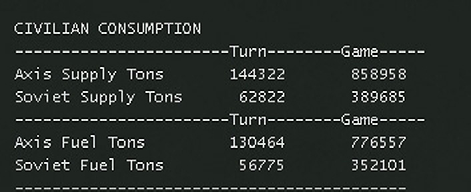
For named vehicles and planes, they are first produced as airframes or chassis and then additional equipment and weaponry is added as required for particular types of that particular tank or plane. So, for example, there is a generic Ju88 airframe and the different models of the Ju88 then alter this as required.
28.2.1 Resource Production
Resources represent the raw materials, such as coal, used by heavy industry factories to produce supplies and by synthetic fuel factories to produce synthetic fuel. The system automatically attempts to ship resources to railyards and then the resources are expended to activate the railyards (in effect the trains use up some coal in the process). Each resource factory point will produce 2500 tons of resources per turn.
Resources move as Freight just like other production items and if rail and/or port capacity is available, can be transported from all player controlled resource “factories,” to include those in occupied countries.
Resource production is modified by the following multipliers:
| YEAR/NATIONALITY | 1941 | 1942 | 1943 | 1944 | 1945 |
|---|---|---|---|---|---|
| German/Czech/Polish | 1.0 | 1.0 | 1.0 | 1.0 | 1.0 |
| Axis Allies | 1.0 | 1.0 | 1.0 | 1.0 | 1.0 |
| Soviets | 1.75 | 1.75 | 1.75 | 1.75 | 1.75 |
This, and related tables, can be found by accessing the in-game editor (41). There, the relevant table can be found under the Nat/Weather tab and shows all these multipliers organised by nationality, as:
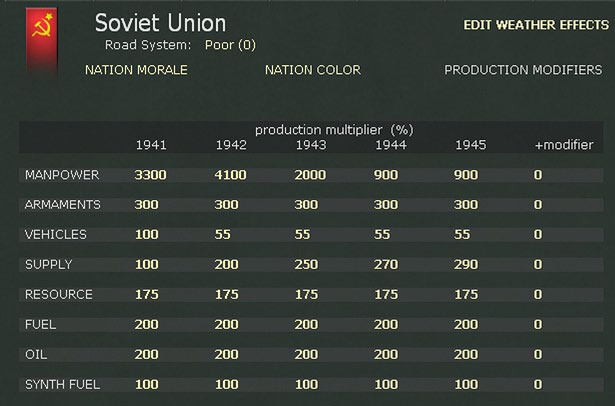
28.2.2 Heavy Industry (Supplies) Production and Allocation
Heavy industry (HI) factories take resources and use them to produce supplies, which represent not only all the materials used in the production of armament points, but also the general supplies and ammunition used to supply units. Note that a shortage of resources (compared to notional demand) will mean that many HI factories operate at lower than maximum capacity.
Each HI factory point will produce a notional amount of 250 tons of supplies per turn at a cost of 1750 tons of resources.
HI production is modified by the following multipliers:
| YEAR/NATIONALITY | 1941 | 1942 | 1943 | 1944 | 1945 |
|---|---|---|---|---|---|
| German/Czech/Polish | 0.4 | 0.9 | 0.9 | 1.1 | 0.9 |
| Axis Allies | 1.0 | 1.0 | 1.0 | 1.0 | 1.0 |
| Soviets | 1.0 | 2.0 | 2.5 | 2.7 | 2.9 |
Lack of resources will mean that not all potential factory production is used each turn and any factories lacking resources will be shown in the logistics log as:

28.2.3 Armament Production
Armament factories take supplies and use them to produce armament points, which are maintained in a virtual pool. Armament points are drawn upon to build devices to equip ground elements.
For example, the build cost of the devices for an 88mm Anti-Aircraft Gun ground element is 55 armament points, which includes one 88mm AA Gun and eight 7.92mm Kar 98 Rifles for the ground element’s eight men. Since all these are produced using the generic armament production, the ground element will draw on the existing ready pools to complete the ground element.
Each ground element has a build cost and this determines how many armament points are used in its production. Ground elements that use devices built using armament points be marked in the “CAPACITY” column of the production screen as ‘ar:xxx’:
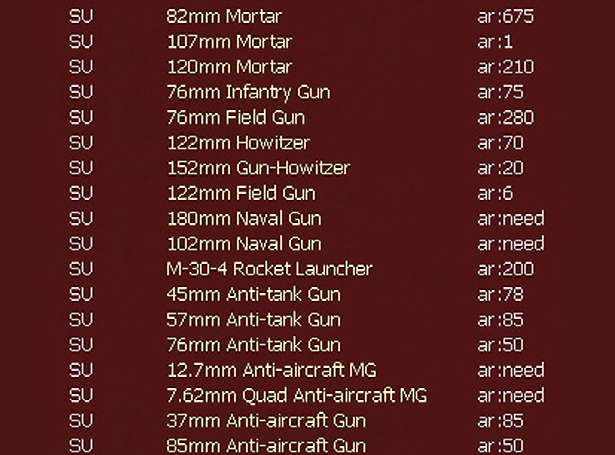
If the ‘ar’ is followed by a number then the production system will try to make roughly that many each turn (subject to available armaments) unless there are 10x that number of items in the pool. However, the set cap will not be exceeded regardless of resource availability.
If the description is ‘ar:need’ then production will vary according to demand and how many of that item are already in the pool.
Note that many of the listed items are actually made up of more than one weapon system. This can be found on the unit production screen and, for example, the actual weaponry produced for a 1942 Soviet Rifle Squad is:

The production of the items that have a set capacity in the previous logistics turn can be found on the logistics tab under ‘production’ as:

Armament factories and production information is listed under the “SPECIAL” section of the production screen.
Elements built by armaments points will often be built ahead of their being used in order to stockpile the elements for future use. Being in demand by units in the field can increase the likelihood that elements will be built to stockpile.
Armament points are used to produce the chassis for aircraft, AFV or combat vehicles which are then built at individual factories.
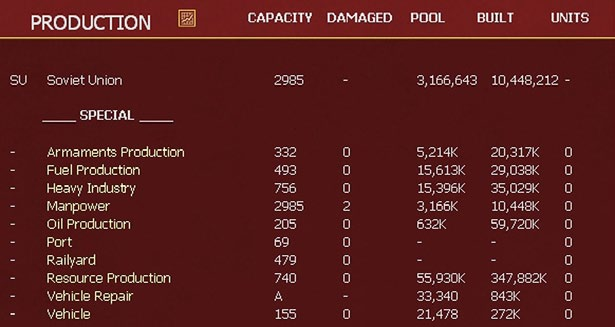
Each Armament factory point will produce a notional 200 armament points at the cost of 50 tons of supplies. Armament point production will be modified by the following multipliers:
| YEAR/NATIONALITY | 1941 | 1942 | 1943 | 1944 | 1945 |
|---|---|---|---|---|---|
| German/Czech/Polish | 3.75 | 5.15 | 5.15 | 7.50 | 7.50 |
| Axis Allies | 1.0 | 1.0 | 1.0 | 1.0 | 1.0 |
| Axis Held Countries (2) | 1.0 | 1.0 | 1.0 | 1.0 | 1.0 |
| Soviets | 3.0 | 3.0 | 3.0 | 3.0 | 3.0 |
Note
- Axis Allies (Rumania, Hungary, Finland, Italy, Slovenia, and Bulgaria) produce armaments for their own pools. None of this production goes to Germany.
- Includes armaments factories in Axis held France, Belgium, the Balkans, Norway and the Netherlands, This production goes directly to the German pool and built numbers.
28.2.4 Synthetic Fuel Production
Synthetic Fuel factories take resources and produce synthetic fuel, which is added to the overall fuel stores pool. Each synthetic fuel factory point will produce a notional amount of 500 tons of fuel per turn at a cost of 2000 tons of resources. Synthetic fuel production will be modified by the following multipliers:
| YEAR/NATIONALITY | 1941 | 1942 | 1943 | 1944 | 1945 |
|---|---|---|---|---|---|
| German/Czech/Polish | 1.0 | 1.4 | 1.4 | 1.4 | 1.4 |
| Axis Allies | 1.0 | 1.0 | 1.0 | 1.0 | 1.0 |
| Soviets | 1.0 | 1.0 | 1.0 | 1.0 | 1.0 |
28.2.5 Oil and Fuel Production
Oil factories (oil fields) produce oil that is then either stored or used by Fuel factories (refineries) to produce fuel, which is also stored in town, city and urban hexes on the supply grid until drawn upon. The normal production rate for oil factories is 1,000 tons of oil per factory point per turn. Each fuel factory point will produce 250 tons of fuel per turn at the cost of 500 tons of oil.
Oil and fuel production is increased by the following multipliers for oil and fuel factories:
| YEAR/NATIONALITY | 1941 | 1942 | 1943 | 1944 | 1945 |
|---|---|---|---|---|---|
| German/Czech/Polish/Axis Allies (apart from Rumania) | 1.0 | 1.0 | 1.0 | 1.0 | 1.0 |
| Rumania | 0.8 | 0.8 | 1.0 | 0.85 | 0.85 |
| Soviets | 2.0 | 2.0 | 2.0 | 2.0 | 2.0 |
Captured oil and resource factories will produce as normal if the hex is connected to the wider supply grid. Captured Soviet oil and resource sites will build at a maximum of 50% of the Soviet multiplier shown above.
28.2.6 Vehicle Production and Repair
Vehicle factories use supplies to produce generic vehicles, which are placed in the motor pool (25.5.1). From there they are drawn to meet the needs of either the motor pool or individual units.
| YEAR/NATIONALITY | 1941 | 1942 | 1943 | 1944 | 1945 |
|---|---|---|---|---|---|
| German/Czech/Polish | 0.5 | 0.7 | 0.6 | 0.6 | 0.5 |
| Axis Allies | 1.0 | 1.0 | 1.0 | 1.0 | 1.0 |
| Soviets | 1.0 | 0.55 | 0.55 | 0.55 | 0.55 |
Each vehicle factory point (modified as above) will produce 10 vehicles per turn at the cost of 50 tons of supplies. Note that vehicles produced by Axis Allies will be placed in the German Motor Pool.
All vehicles, also known as trucks, are considered as 2.5 ton equivalents. Individual vehicles that are damaged are returned to a virtual pool for repair. Once repaired, they are added back into the motor pool. Repair takes place during the logistics phase.
The repair rate for the Germans is 5% in 1941/42 and 10% for 1943-45. For the Soviets, the repair rate is 25%. This reflects the relative lack of standardized equipment that was a major problem for the Germans.
28.2.7 Naval Production
For both sides this is abstracted.
On the first turn of each month both sides will receive reinforcements of cargo and troop ships. Germans get 1 of each in the Baltic and Black Seas each month. The Soviets receive 1 transport in the Black and Baltic Seas each month. They also receive 4 cargo ships in the Black Sea, 2 in the Baltic and Caspian Seas, and 1 in the Sea of Azov and Lake Ladoga each month. In addition, as long as they have a friendly port for these sea zones, each side will receive enough cargo ships to have a minimum of 5 cargo ships each turn (the Germans only ever have ships in the Black and Baltic Seas regardless of if they have captured ports on other sea zones).
28.3 Manpower Production and Migration
Population is a permanent characteristic of a town, city or urban hex and is provided for reference. A population point represents 50,000 people (in the town, city, urban hexes or surrounding area).
Manpower, represented by factories in town, city or urban hexes, is produced at a variable rate dependent on nationality and the year. Manpower factories can be damaged, destroyed, or can migrate to other town, city and urban hexes.
Each nation has a separate manpower pool. Polish and Czech manpower generated for the Germans is placed directly into the German pool. The number of men added to each nation’s manpower pool is determined each turn by taking the number of available manpower factory points times a manpower production multiplier. Manpower is maintained in the pool until the system draws men from it to match with equipment to build ground elements. Manpower multipliers are as follows:
| YEAR/NATIONALITY | 1941 | 1942 | 1943 | 1944 | 1945 |
|---|---|---|---|---|---|
| Germany (1) | 1.0 | 6.0 | 12.0 | 14.0 | 8.0 |
| Axis Allies | 10.0 | 11.0 | 10.0 | 10.0 | 8.0 |
| Soviets | 33.0 | 41.0 | 20.0 | 9.0 | 9.0 |
German manpower will be increased as various events (40.15) occur. Some are related to actions on the Eastern Front and other due to Western Allied progress in the West Front theatre box.
Note (1) Includes Axis Czech and Poles, but only ten percent of this manpower (by location) is actually placed in the German pool. Manpower recruited from Luxembourg is allocated at the normal rate as if it was a German nationality manpower centre.
Remember that the manpower generated by a country has to cover all the demands it faces both on the map and in the various Theatre Boxes.
28.3.1 Manpower Evacuation and Migration
Manpower factory points of German or Soviet nationality town, city and urban hexes may evacuate/migrate when the hex is captured by enemy units. For purposes of migration, each manpower factory point represents 50,000 people. There is no limit to the amount of migration that can occur in a turn.
The more manpower factory points in a hex, the better the chance some will migrate. When manpower factory points migrate, they will try to move to another town, city or urban hex (including off map cities) at least 14 hexes away from an enemy unit. Town, city or urban hexes re- captured by friendly units will not undergo migration.
28.3.2 Manpower Factory Damage and Destruction
Manpower factory points can be damaged and/or destroyed whenever combat occurs in a town, city or urban hex, and whenever control of a town, city or urban hex changes.
Manpower factories can also be damaged and/or destroyed through lack of supply (28.3.3).
28.3.3 Manpower Losses Due to Poor Supply
Every turn town, city and urban hexes must trace supply and will suffer a starvation damage percentage equal to the supply path MP cost minus 5. For example, suppose a city has to trace 13 MPs to the nearest railhead due to a combination of destroyed rail, contorted lines and enemy ZOCs. This would result in the city adding 8 percent each week to its manpower damage percentage.
Manpower factories recover 3 percentage points per turn, so the net increase in damage would be 5 percent per turn. If a town, city or urban hex cannot trace a supply path and is isolated it takes 25 percent starvation damage every turn.
When a town, city or urban hex’s manpower reaches 100 percent damage, additional damage may cause the permanent loss of manpower factory points from the hex. Town, city and urban hexes will only take starvation damage if a supplied enemy unit is within four hexes of the hex. This will be offset if they can trace a path of friendly ground hexes to a railhead of four hexes or less, regardless of enemy ZOC or the number of MPs to the railhead.
Manpower production centres that are isolated will not produce any manpower till they are linked back to the main supply networks (25.9.2).
28.4 Aircraft, AFV, and Combat Vehicle Production
The chassis for aircraft, AFV and combat vehicles are built at individual factories by using Armament Points, with one item being built for each factory point. In WiTE2, aircraft and AFVs are built as airframes or chassis which are subsequently converted to actual combat planes and vehicles.

For example, assuming sufficient resources are available, the He 111 factory in Rostock, with a capacity of 23 factory points, will build 23 He 111 airframes every turn.
Aircraft, AFV and combat vehicles include installed devices, but will not become complete ground elements until they are matched with manpower for the crew, during the replacement segment.
28.4.1 Production of Airframes and Vehicle Chassis
The production screen shows the capacity to build each type of basic airframe or chassis each turn as:
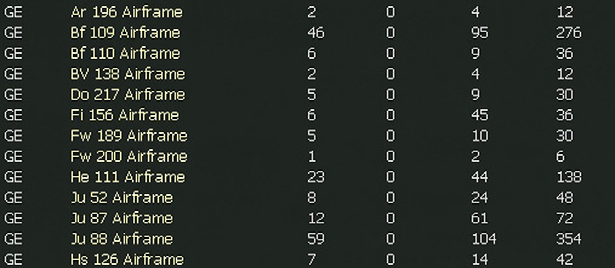
Clicking on the airframe or chassis will take you to a list of the factories that currently produce that item.

The airframes and chassis are converted to particular planes or vehicles.
Each tank or combat vehicle currently in production has a capacity indicated as ch:000. The number after the ‘ch’ is the maximum number of chassis that can be converted to actual vehicles in any one turn.
Each aircraft type currently in production has a capacity indicated as af:000. Again the number after the ‘af’ is the maximum number of those planes that are produced each turn.
The cost of building a chassis is taken as supply points. Each supply point is the equivalent of a quarter ton of supplies and each build cost (for the chassis) demands 1/16 ton of supply. So a chassis with a build cost of 40 will use 2.5 supply points.

The actual building of the combat element requires armament points. For example a Bf 109F-4 has a build cost of 388 so requires 388 armament points to produce one such aircraft. The total production cost includes the frame and supporting items such as the 20mm cannon and 2 7.92mm MG17 as installed devices as well as integral aircrew.
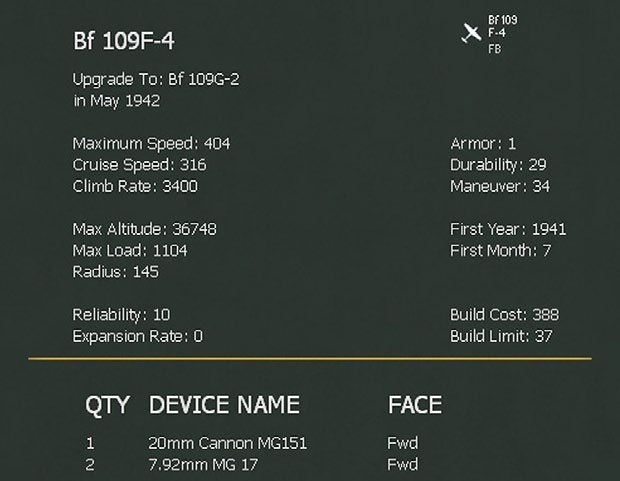
The cost of a given vehicle or plane can be seen in the commanders report in the Equipment screen (35.8) as well as by opening up the detailed tab for the unit type (37.6).
Once produced, each aircraft of a specific type is placed in a separate pool until it is drawn upon as a replacement. AFV and combat vehicles go to their specific AFV/Combat Vehicle pool until the system determines that both the need exists to build that type of ground element and sufficient manpower is available.
Note that ground elements that have a build cost of 9999 will never be produced.
28.4.2 New Aircraft Types
A new plane model cannot be used to re-equip existing air units for the first month after it enters production.
For the Soviet player, it may be used to equip completely fresh air units that have been raised in that period and allocated to the National Reserve.
28.4.3 Usage of Damaged Equipment
Damaged equipment and manpower returned to the pool during the logistics phase are not available immediately to be used as replacements. Although they appear in the pool on the production screen, they actually are put in a “transit pool”.
At the start of each friendly logistics phase, 25 percent of the amount in the transit pool is moved to the available pool. This represents the lost time from the front of lightly wounded soldiers and damaged equipment.
While the default setting is to show all pools, the production screen can be toggled to display only the amount in the active or transit pools. The example below shows some of the tanks in the German transit pool in early August 1941.
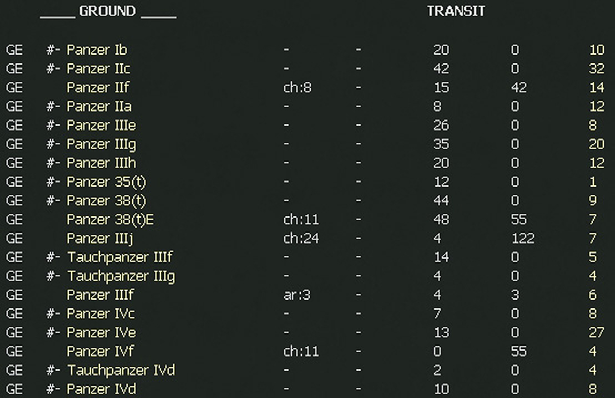
28.4.4 Aircraft, AFV, and Combat Vehicle Factory Expansion and Build Limit
Aircraft, AFV and combat vehicle factories may be able to increase their capacity to convert frames and chassis by adding additional factory points over time.
Factories may alter in size over the game according to scripted events.
Each type of Aircraft or AFV/combat vehicle ground element equipment has a build limit that will cap expansion at a fixed number of items per factory location per turn.
28.4.5 Factory Production
Each type of aircraft or ground element equipment factory has a start production date (first year/first month) and may have a stop production date (last year/last month) Factories with a stop production date will disband when the end of the last month in the last year is reached. Production of new types of aircraft or ground element equipment can occur in two ways. Some new types will appear as new factories when their start production date is reached.
For example, the German Panther A medium tank will commence production in September 1943 with a newly built factory in NE Berlin. Other new types will start production as a result of an existing type of factory being redesignated. Multiple changes of a factory to a new type are possible over time, with the old type ceasing production when the new type starts. Continuing the example, the Panther A factory in NE Berlin, with a build limit of 11 will be upgraded to produce the Panther G, with a build limit of 10 in May 1944. Change of role for a factory only happens after an aircraft or ground element reaches its final month of production (until then it keeps producing the older item).
28.5 Port and Rail Yard Capacity
Ports and Railyards are treated as factories in terms of capture, damage and repair, with the exception that ground combat in a hex does not cause any damage to a port.
Damage to railyards and ports will reduce their tonnage capacity and ports with five percent or more damage will only operate at one half of their normal capacity.
Ports and Railyards play only a peripheral part in the production system, but are a critical part of the supply grid and serve as logistics hubs for naval and rail transportation.
Ports will automatically attempt to secure supplies to be kept at the city hex where the port is located.
28.6 Factory Capture, Damage, and Repair
Factories will be captured and damaged or destroyed when the city hex that they are located in becomes enemy controlled. Factories can also be damaged by strategic bombing. Damaged factories will be repaired automatically, but the player can use priority repair to focus additional repair efforts on specific factories. Port and Railyard factories (levels) in hexes with depots have an automatic priority repair function.
28.6.1 Captured Factories
Factories in captured town, city and urban hexes can be damaged or destroyed. With the exception of manpower, port, railyard, resource, heavy industry, fuel, synthetic fuel and oil factories, all other factories in captured hexes are destroyed and permanently removed. Those not removed will be damaged.
With the exception of manpower factories, factories that remain will receive a variable amount of damage (damage will be added to the factories equal to 25+random(75) percent (not to exceed 100 percent)). In addition, oil factories are always set to 100 percent damage when captured.
Captured oil and resource factories will commence producing once damage has been repaired to be less than 50 percent, assuming the hex is linked to the applicable supply grid. No other captured factories will produce. Captured factories will produce at the rate of their actual nationality, except that captured Soviet oil and resources will build at only ½ the Soviet multiplier.
Note that Soviet factory evacuation will occur as set out in section 28.7.
28.6.2 Factory Damage
In addition to capture damage, all factories can be damaged by the strategic bombing (bomb city) air mission (18.1.5).
Damage is applied to an entire factory, not to individual factory points. The damage level of a factory is also the probability that the factory will not produce on a given turn.
For example 100 damage means no production, while 25 damage means 25 percent chance of no production and a 75 percent chance of full production. For example a FW-190 aircraft factory with 12 factory points, or size 12, which had 40 damage would have a 60 percent chance of producing 12 aircraft and a 40 percent chance of producing 0 aircraft.
28.6.3 Factory Repair
Factories will automatically repair themselves during the logistics phase at a rate determined by the type of factory.
Factories located in isolated hexes cannot be repaired.
Note that Manpower is repaired like other factories to reflect the disruption effects of general bombing on the population. Not only is remaining population less effective at production, they also have to be put to work repairing damage and taking care of the displaced population.
Manpower repair represents the reduction of disruption effects over time.
| TYPE OF FACTORY | REPAIR RATE PER TURN |
|---|---|
| Oil, Resource | 1% |
| Heavy Industry, Synthetic Fuel, Fuel | 2% |
| Armament, Vehicle, Manpower, Aircraft and AFV/Combat Vehicle, Port, Railyard | 3% |
There is an adjustment to the repair percentage based on the size (number of points) of the factory as follows:
- If factory size is 1-3, multiply basic repair rate ×3
- If factory size is 4-6, multiply basic repair rate ×2
28.6.4 Priority Factory Repair
The priority factory repair functions allows player to use construction support units to focus repair efforts at the cost of admin points. Players may pay 1 AP and set a factory for priority repairs by accessing the city detail window (37.13) from the general information and city/airfield box (6.2) and then selecting the damage level of the factory they desire to institute priority repair.
An asterisk indicates that priority repairs have been instituted and selecting the damage again will terminate priority repairs.
Setting a factory to priority repairs will result in HQ units automatically assigning construction support units to the hex during the logistics phase. This is the same process as automatic rail line repair (21.6), and there is a limit to the distance that the automated construction units will operate from the HQ unit that they are attached, based on command range (21.11.4).
A support unit may only work on one factory per turn and no more than 25 percent of the damage to a factory can be repaired during the logistics phase.
Additional repair units may be called to the hex. Also, since regular repairs are conducted after priority repairs, and they happen even when priority repairs have been completed, once the damage level gets very low, continuing priority repairs can be very inefficient, with only a small amount repaired by priority repairs. Priority repairs may never repair more than 20% of the damage of a factory in a single turn.
28.6.5 Port and Railyard Factory Priority Repair
Hexes with depots will automatically attempt to find construction units to attempt priority repairs on ports and railyards in the hex. This does not cost APs and it will not have the factory item flagged with an asterisk (only player directed priority repairs will flag the factory item in the city detail window). This function is set at a lower priority than any player directed priority repairs.
Both the HQ unit supplying the construction unit and the location being repaired must be in supply.
Damaged ports and railyards at depots will only get automatic priority repair from a construction support unit if the item is damaged at over 30 percent, (if a port and railyard, then if the combined damage is over 30% then it will try to get help). Also, for repairs at depots, a construction unit can split it’s time to help repair both the port and the railyard, with the port getting the priority between the two.
28.7 Soviet Factory Relocation
In WiTE2, the process of Soviet factory relocation in the face of Axis gains in 1941 and 1942 is fully automated. Basically those factories that were historically redeployed can be moved (and will usually do so automatically) and those that were overrun cannot be relocated.
These factories will evacuate in one of three ways:
- The Soviet player can manually evacuate them early;
- They will relocate on the historical date; or.
- They will relocate if the Axis capture their location.
- If they are evacuated using the first or third manner they will take more damage and longer to come back into full operation.
- Factories being relocated take up rail capacity during the logistics phase.
- Information about factory relocations can be found in the Factory Navigation panel (CTRL-N).
This will produce a screen that shows all the factory changes planned, including dates for relocation, upgrade, change of production and expansion:

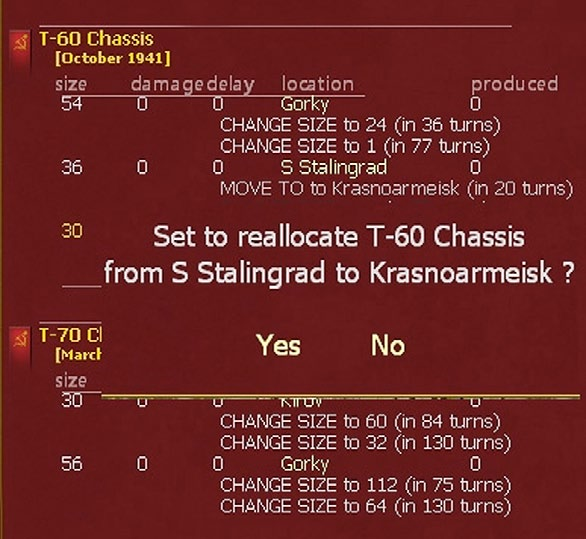
28.7.1 Manual Evacuation
- To manually redeploy factories select the ‘factory navigation panel (either the button at the top, or using CTRL-N, or right click on a hex, select map information > Factory Navigation).
- In this window, if you click on the “Move to…” text (shown in yellow) you will be given the option to order the immediate movement of the factory.
- In this case, the T-60 production in S Stalingrad is due to move to Kastnoarmeisk in 20 turns. Clicking on that entry brings up the dialogue shown and the ability to force the factory to move this turn.
28.7.2 Automatic Evacuation
This will happen either at the historical date when a factory was moved or if the Axis captures the location before this date.
28.8 Production to Other Fronts
Given the use of the various Theatre Boxes, in effect WiTE2 reflects the totality of the war effort of both the Soviet Union and Nazi Germany and their allies. As such production is not allocated outside of the game but instead is also used up by the demands of other theatres than the main focus of the struggle between the two powers.
However, Germany will transfer planes, tanks and armament points to their various allies. The latter will happen if Germany has greater than 100,000 armament points at the start of the production segment of the logistics phase, any Axis allied nation with less than 1,000 armament points will be provided 1,000 armament points from the German armament pool.